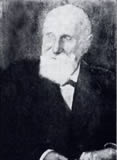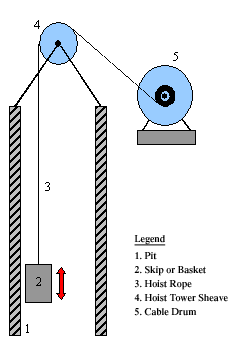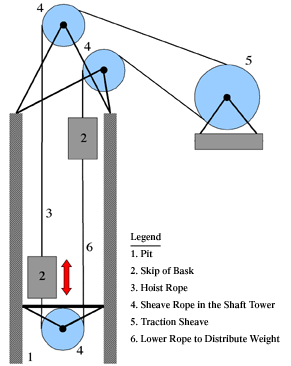> Koepe-Hoist
Our History
Inventions have existed since the dawn of human thinking. Legal protection of inventions and ideas, however, has only existed in Germany for about 125 years, with the introduction of the first Patent Act in 1876. Friedrich Koepe, Patent Attorney Gerd Koepe’s great-uncle, was one of the very first patent applicants in Germany with his traction sheave hoist (Treibscheiben-Förderung) in the mining industry. His employer at the time, the Friedrich Krupp Company, however initially refused to apply for a patent for the new technology, prompting the mining engineer Koepe to obtain the patent in his own name in 1877. Two years later, once the technology had proved successful and the Krupp Company demanded that Koepe surrender his patent rights, litigation between the two parties ensued.Friedrich Koepe: A Short Biography
 Carl Friedrich Koepe was a pioneer in conveyor technology for the mining industry.
Carl Friedrich Koepe was a pioneer in conveyor technology for the mining industry.He was born on July 1, 1835 on the family farm in Bergkamen, the second youngest child of farmer Friedrich Sr. and his wife Friederike, née Telgenkämper.
He began his career in the mining industry as a pitman and hauler in an underground mine in Ibbenbüren in the Teutoburg Forest. After attending the Märkische Bergschule (Mining School) in Bochum, he worked as an overman and machine foreman in various coal mines in Ibbenbüren and the Ruhr region. In 1873 he became the technical director of various mines owned by the Krupp Mining Company.
In 1876/1877 Koepe developed the groundbreaking invention that would later completely revolutionize coal hoisting technology and at the same time lay the foundation for modern elevator technology: friction as drive. He developed an elevation device based on a traction sheave (Treibscheiben-Förderung) that was technically superior, more economical and more versatile than the traditional cable drum (Trommelförderung). The Koepe hoist technology became the standard elevation device throughout the mining and similar industries. By the turn of the century, his new technology was already being used in mines in England and America.
The terms “Koepe Hoist“ and “Koepe Winder“ have kept their same technical meanings to the present day and are now part of standard mining terminology. “Four-rope Koepe Hoist“ and “Endless-Rope Winder“ are similarly established concepts in the industry.
Carl Friedrich Koepe died in Bochum in 1922, at the age of 87.
Source: http://de.wikipedia.org/wiki/Carl_Friedrich_Koepe (7.4.2005)
The Invention: The Koepe-Hoist
The Limits of Traditional Coal Extraction Around 1850Increases in pit depth and load weight in combination with the traditional drum-based hoisting principle meant that coal extraction technology, around the middle of the nineteenth century in Germany, was reaching its capacity in terms both of worker security and economic feasability. The situation demanded new ideas to solve the problem of increasing usable loads, hoisting speed and rope endurance while at the same time decreasing dead weight during the hoisting cycle (see: Hundert Jahre Patent, p. 152, published by the German Patent and Trademark Office in 1976). The traditional drum hoisting principle is shown in Figure 1.

Figure 1: Traditional Drum-Based Hoist
Description and Advantages of the Koepe Hoist
Carl Friedrich Keope’s invention provided the necessary solution in 1877. The basic principle of his idea was to wrap the end of the rope coming out of the elevator shaft around a large traction sheave and then to continue it directly back down the shaft. In this way, a basket could be attached to each rope end. The baskets were thus conveyed from above to below-ground and vice-versa (see Figure 2).
In this new embodiment, the traction sheave was 7.3 meters in diameter, contained a groove in its oaken edge to better secure the hoist rope, and was itself the flywheel of a single cylinder machine. Further sheaves in the hoist tower served to redirect the ropes and thereby provided more flexibility in the placement of the said traction sheave. At the same time, the risk of rope slippage was reduced due to the steeper enlacement angles around the sheaves. Furthermore, the use of parallel traction sheaves lessened the risk of rope breakage, since the more evenly distributed weight allowed each rope to be thinner and thus more flexible.
Koepe’s new invention also included a catch mechanism which secured the basket in cases of rope breakage (not shown in Figure 2). This consisted of placing two pulleys on a spring-mounted axle directly over the pit, each of which held one safety rope. If the main hoist rope broke, the weight would first be secured by the safety ropes. The hoist would then come to a standstill via a mechanism which applied special brake shoes to the pulleys. This combination of a catch mechanism (with 2 safety ropes) and parallel traction sheaves (with 2 main hoist ropes) has come to be known as a “Four-Rope Koepe Winder“.
The Koepe Hoist was also an improvement with its technique of even weight distribution. Traditionally, the weight distribution had been uneven during a hoisting cycle, which meant that the load resistance for the powertrain was not constant: compare lowering an empty basket and a short length of rope on the one hand and raising a full basket plus between 1000 and 1500m of rope on the other.
In order to keep the resistance on the powertrain constant and to reduce the load weight to the actual payload, Koepe connected the bottom of the two baskets via a so-called underrope, which was guided around a sheave below the floor of the shaft. This type of hoist, with its closed rope system, gave rise to the term “Endless Rope Hoist“.

Figure 2: Koepe Hoist in Coal Mine
The original patent that issued from Friedrich Koepe’s application in 1877 is shown below.



